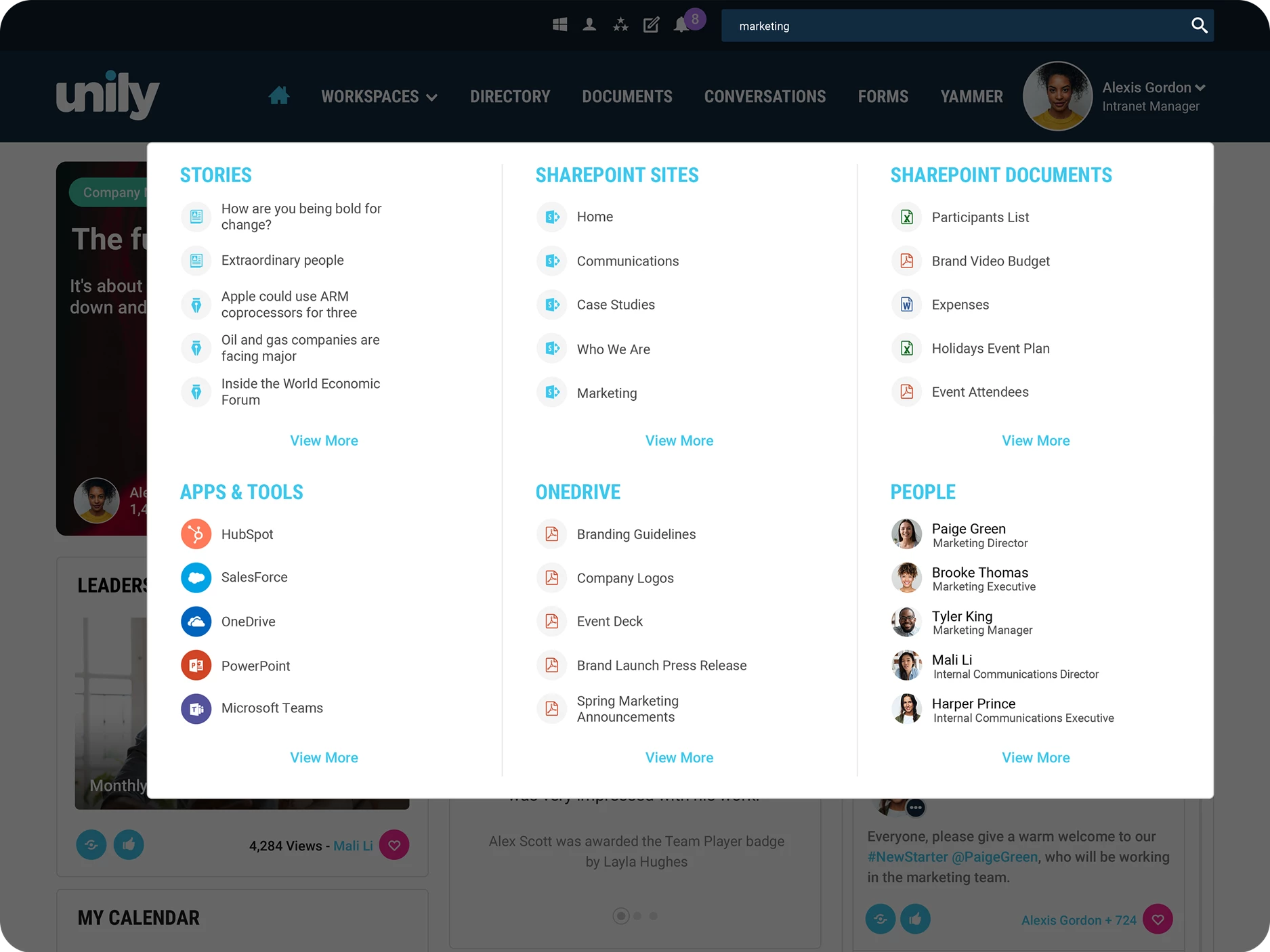Why your enterprise needs a digital front door
Whether you’re a new starter or a C-suite executive, you need somewhere to turn to for information and updates. With hybrid work, your intranet is the first step of that journey; the digital front door to your enterprise. Everyone travels through that door to get to where they need to be, so it pays to follow these six steps and make your platform as engaging and productive as possible.

Why your digital front door matters
Hybrid working is in full swing. Digital tools power more and more of our work, and employee experience platforms have stepped up as the core of the digital workplace.
With enterprises relying on the intranet as the go-to digital hub, the need for every visit to be productive – for employees to efficiently find exactly what they came for – has increased.
For this reason, many are beginning to rethink the look and feel of their intranet with the goal of creating the perfect digital front door to the wider enterprise. With the right mix of intelligent design, relevant content, and useful features, enterprises stand to make significant productivity, alignment, and engagement gains as hybrid work continues.
What role does an enterprise front door play?
James Robertson, a DEX expert of 20 years and author of Designing Intranets: Creating Sites that Work, offers a useful breakdown:
"An enterprise front door provides a jumping-off point to the broader digital workplace and provides visibility of what’s happening."
For the first point, your intranet needs to deliver a single pane of glass experience. This means integrating with the wide array of enterprise technology and bringing the apps and tools your employees need into one seamless experience.
To provide visibility, your intranet needs to offer all the latest updates happening across your organization at a glance. To save employees aimlessly searching for information, personalized and targeted experiences, news and social feeds, push notifications, mandatory reading, and integrated widgets can all be leveraged to offer a real-time view of what’s happening across the business.
6 keys to the perfect digital front door
To help you on your way, we’ve collected our six keys (see what we did there?) to creating the perfect digital front door:
#1. A personalized, relevant experience
Walk down your street and look at all the properties’ front doors, and you’re going to see a lot of variation. Everyone is different, everyone needs different things from your intranet, and so your intranet’s front door needs to be different for each person, too.
Everything from the content people see to the language that they read it in should automatically factor into what your homepage looks like when users first log on.
To achieve this, homepages need to be adaptable and flexible, targeting individual users with personalized experiences for maximum user engagement. This ‘Netflix experience’ could take the form of targeted news feeds like a ‘For You’ or ‘Local News’ feed, or a recent activity widget that shows posts and changes to the social channels users subscribe to or the Teams groups they’re members of.

This kind of personal touch makes homepages more engaging for employees, more useful as a go-to hub of information, and more effective as a welcoming digital front door for your enterprise.
#2. All you need in one place
Forrester Research recently revealed that in 2022, optimizing digital experiences and offering a unified view of digital tools and channels is a top priority for more than 80% of C-suite leaders. So, if you’re creating a digital front door to the wider enterprise, addressing digital complexity needs to be a top priority.
The number of apps and tools we use at work is rising, and that’s taking its toll on employees according to Gartner:
- 68% of workers spend much of the day toggling between apps
- 28% of employees’ time is spent exclusively on emails
- 20% of employees’ time is spent looking for information
- Employees context switch between different apps and UX 400 times a day
Nobody’s opening a door if they know what’s behind it will only make their life harder, so your digital front door needs to optimize employees’ path to tools and apps and bring your array of enterprise technology into one consolidated view.

Aim to create a single pane of glass experience of your wider digital workplace by making use of plug-and-play integrations, customizable apps and tools lists, people directories and social feeds, and an integrated search experience.
#3. Powerful search at your fingertips
Providing an efficient, powerful search function directly from your homepage is arguably the most important functional aspect of any intranet software, as it holds the potential for significant productivity gains:
"Employees spend 1.8 hours every day—9.3 hours per week, on average—searching and gathering information. Put another way, businesses hire 5 employees but only 4 show up to work; the fifth is off searching for answers, but not contributing any value."
Search is going to be the main reason for most sessions on your homepage, so ensuring your search bar is easy to find and allows users to instantly search across your platform from one place, including integrated applications, is key to making sure all that traffic is productive.
The best example of this is Google. People go to Google – one of the most used websites in the world – for information, so what takes up 90% of the page? The search bar.

A unified search center delivers that “Google-like” search experience that connects people to what they need in seconds, breaking down business silos in the process by pulling integrated systems and repositories into one place.
Whether you’re looking for a useful document or the latest ticket in ServiceNow, allowing users to find it all with one search means your digital front door doesn’t just look good; it’s also a major productivity booster.

#4. Single sign-on simplicity
You’re walking up to your front door; bag in one hand and keys in another. You put in your front door key, turn, and you’re in, right?
Now imagine that you had to use three different keys just to get that same lock open. It’s not any more secure than the one key, and it takes you three times as long.
When you first move in, it might not seem like a problem, but after the hundredth time of fumbling with those keys, you’re going to get pretty frustrated. This is a great way of thinking about accessibility for your enterprise’s digital front door, too.
Take this premise and apply it to your intranet login: making users sign in multiple times or with multiple identities is just poor UX, plain and simple. Single sign-on (SSO) security should be the standard, securely authenticating users in your own systems without forcing employees to duplicate login credentials or jump between systems.

You can even take this one step further and offer users the ability to sign in securely with multiple identities, allowing them to verify whatever login is most convenient to them against your systems. This feature can be extremely useful for frontline employees that may not have logins for other systems, but are already signed into Facebook on their phone – not only saving them time but also making your intranet a more welcoming and accessible digital front door.
#5. Engaging design
Intranet design is about creativity and expressing your culture and story through user experience. This is true of your entire platform, but particularly when it comes to your homepage. A successful homepage design weaves in elements that reflect the identity of your organization, culture, and people, yet offers users tangible, useful tools that empower them to do their best work.
A big part of intelligent design is about anticipating user needs and behavior, so certain elements of your platform design need to factor in the logical, step-by-step kind of thinking that makes tasks and processes, and by extension your employees, more efficient.

Ultimately, intranet design is going to be unique to each and every organization. There’s no one-size-fits-all approach, so you’re going to need to listen to your employees and stakeholders, follow best practices, and find a little inspiration. Luckily, this free guide has you covered:
#6. Clear, consistent branding
A perfect digital front door isn’t going to be generic. Users should be able to tell that this is your organization’s intranet just from a glance at the homepage.
Design should reflect your culture and identity, so color palettes, logos, and even the layout need to be crafted with your brand identity in mind.
This is particularly important for large, complex organizations with various sub-brands and regional branches, typically seen in global Fortune 500 enterprises.

Consolidating various arms of an organization, often with unique and conflicting brand identities, demands full control over theming and design. Subsites should be visually distinct and immediately identifiable, and this extends to the way people access these sites, too. From your homepage, first-time users should instinctively be able to access their sub-brand site, so the color of links or buttons or the imagery used, and how this affects the time it takes to find, needs to be considered.
A digital gateway or a door to nowhere?
Many enterprises are trying to create the perfect digital front door as remote and hybrid working continues as the norm. The issue is, without the right guidance or planning, many platforms end up losing their way, offering dead ends instead of a front door.
If you’re looking to create the perfect digital front door for your enterprise’s digital workplace, get in touch with an expert today.
Get started. Get your personalized demo.
Reinvent your intranet for the employee experience era.













